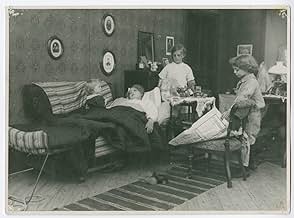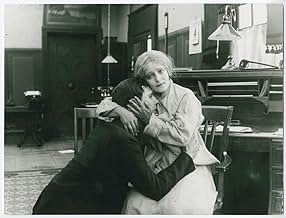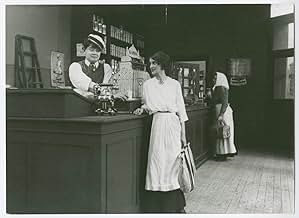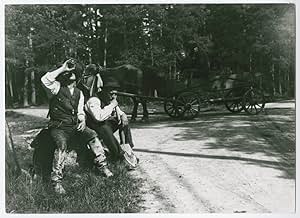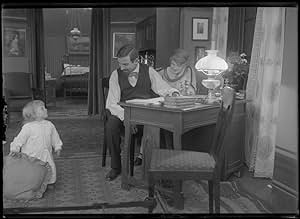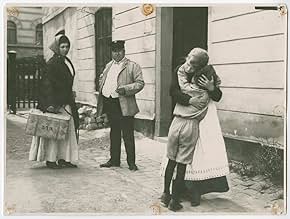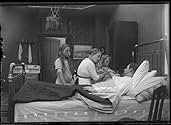NOTE IMDb
7,0/10
1,5 k
MA NOTE
Ajouter une intrigue dans votre langueFinancial struggles separate a single mother from her children.Financial struggles separate a single mother from her children.Financial struggles separate a single mother from her children.
- Réalisation
- Scénario
- Casting principal
Avis à la une
The classic narrative films so familiar in "The Golden Age of Hollywood" movies had its beginning in October 1913 with Sweden's "Ingeborg Holm." Writer/director Victor Sjostrom adapted the Nils Krok 1906 play about a family who sinks to the depths of poverty after the father dies just as he assumes ownership of a store.
What sets "Ingeborg Holm" apart from the movies produced previously to the autumn of 1913 was the breath of its plot. Instead of taking a slice of a full-scale biography of the characters and producing a film on one particular stand alone event, here Sjostrom portrays an entire family's history, beginning when the head of the household receives bank funding to begin his enterprise. He continues the plot until years later, concluding in an emotional reunion with the mother and her long-absent son.
"Ingeborg Holm" fits all the criteria in cinema's full narrative definitions. A classic narrative begins by introducing all the characters who will propel the plot forward, just as Sjostrom illustrated with the comfortable middle-class family embarking on its new enterprise. Narratives contain a triggering event which shakes things up. Here, the father dies and his assistant at the store rips off the family's profits. Sjostrom continues the narrative plot by showing the mother-led family sinking into poverty, with the kids shunt off to the poor house. Events lead up to the conclusion, where the director visually reveals Sweden's lack of a safety net for the country's poor caused by, through no fault of themselves, their hardships.
Hollywood would follow Sjostrom's pattern of full narrative movies, especially during its classic 1930's--1950's golden age. There are variations of the narrative pattern in movies today, but the Swedes were the first to put into practice on film what literature and drama had been delivering for centuries.
Today's movie viewers may be familiar with Sjostrom by his last appearance on the screen in Ingmar Bergman's 1957's "Wild Strawberries," where he had the leading role of an aging professor who rediscovers his past through a journey to receive a honorarium.
What sets "Ingeborg Holm" apart from the movies produced previously to the autumn of 1913 was the breath of its plot. Instead of taking a slice of a full-scale biography of the characters and producing a film on one particular stand alone event, here Sjostrom portrays an entire family's history, beginning when the head of the household receives bank funding to begin his enterprise. He continues the plot until years later, concluding in an emotional reunion with the mother and her long-absent son.
"Ingeborg Holm" fits all the criteria in cinema's full narrative definitions. A classic narrative begins by introducing all the characters who will propel the plot forward, just as Sjostrom illustrated with the comfortable middle-class family embarking on its new enterprise. Narratives contain a triggering event which shakes things up. Here, the father dies and his assistant at the store rips off the family's profits. Sjostrom continues the narrative plot by showing the mother-led family sinking into poverty, with the kids shunt off to the poor house. Events lead up to the conclusion, where the director visually reveals Sweden's lack of a safety net for the country's poor caused by, through no fault of themselves, their hardships.
Hollywood would follow Sjostrom's pattern of full narrative movies, especially during its classic 1930's--1950's golden age. There are variations of the narrative pattern in movies today, but the Swedes were the first to put into practice on film what literature and drama had been delivering for centuries.
Today's movie viewers may be familiar with Sjostrom by his last appearance on the screen in Ingmar Bergman's 1957's "Wild Strawberries," where he had the leading role of an aging professor who rediscovers his past through a journey to receive a honorarium.
Again, this is an early not-that-bad drama from Sjostrom about a person driven mad by tragic circumstances. It has a nice sense of restraint, especially for its era, with a fine performance by Hilda Borgstrom and a well-paced story. Nothing about the movie sucks. It just takes a little something extra for me to get involved with a silent film... some sort of avant-garde twist or dazzling technique or some thrilling action. Yeah, it's a good plot with a sympathetic protagonist, but my heart just wasn't in it. I can't imagine anyone besides a Sjostrom scholar watching this more than once.
6/10
6/10
In conjunction with its release of THE OUTLAW AND HIS WIFE, Kino has also given us this splendid double bill from Victor Sjostrom (Seastrom in America) who was truly one of the world's great directors. His influence on other Scandinavian filmmakers (Ingmar Bergman and Carl Theodor Dreyer to name two of the best known) is clearly evident although with INGEBORG HOLM (1913) you could say he influenced many others as well. This film is incredibly well made for a film of its vintage. Although the camerawork is first rate it's the restrained naturalistic style of the acting by star Hilda Borgstrom along with the seriousness of the thematic material that really makes you sit up and take notice.
D. W. Griffith had explored social themes in his Biograph shorts before this but never in a feature length film and similar socially concious movies like TRAFFIC IN SOULS (also 1913) were not as dramatically sophisticated. The story of a widow whose husband leaves her bankrupt and is forced to live in a workhouse where she must give up her children to foster parents, works as both social indictment and dramatic tragedy. It's hard to watch this film and not become emotionally involved in the plight of the title character. The score by David Drazin is simple but effective using primarily piano with a few synthesized strings.
The other film on the disc, A MAN THERE WAS, dates from 1917 and is based on an epic poem (TERJE VIGEN) from the great Norwegian dramatist Henrik Ibsen (PEER GYNT). The English title cards are even an approximation of his poetic writing style which may be tough going for some but they add quite a bit to the visual narrative. Full of lots of natural location shooting including the open sea, MAN explores a variety of powerful emotions as a fisherman during the Napoleonic Wars is wrongfully imprisoned which results in the death of his family.
Many years after his release he is presented with the opportunity of saving the family of the man who sent him to prison. Donald Sosin's piano score is very effective especially during the sea sequences but it would have been nice to have a chamber or orchestral score to accompany the film. Nevertheless this is an important set from one of the great early film pioneers and as such should not be missed...For more reviews visit The Capsule Critic.
D. W. Griffith had explored social themes in his Biograph shorts before this but never in a feature length film and similar socially concious movies like TRAFFIC IN SOULS (also 1913) were not as dramatically sophisticated. The story of a widow whose husband leaves her bankrupt and is forced to live in a workhouse where she must give up her children to foster parents, works as both social indictment and dramatic tragedy. It's hard to watch this film and not become emotionally involved in the plight of the title character. The score by David Drazin is simple but effective using primarily piano with a few synthesized strings.
The other film on the disc, A MAN THERE WAS, dates from 1917 and is based on an epic poem (TERJE VIGEN) from the great Norwegian dramatist Henrik Ibsen (PEER GYNT). The English title cards are even an approximation of his poetic writing style which may be tough going for some but they add quite a bit to the visual narrative. Full of lots of natural location shooting including the open sea, MAN explores a variety of powerful emotions as a fisherman during the Napoleonic Wars is wrongfully imprisoned which results in the death of his family.
Many years after his release he is presented with the opportunity of saving the family of the man who sent him to prison. Donald Sosin's piano score is very effective especially during the sea sequences but it would have been nice to have a chamber or orchestral score to accompany the film. Nevertheless this is an important set from one of the great early film pioneers and as such should not be missed...For more reviews visit The Capsule Critic.
A woman loses her husband and children in quick succession as the hand of fate lands her a tragic blow. Good direction, cinematography and acting for the time make this one of the essential silents and a standout in Scandinavian and world cinema. A must for fans of film history and movies in general.
10mmipyle
Over the weekend I watched "Ingeborg Holm" (1913), directed by Victor Sjöström, and starring Hilda Borgström as Ingeborg. This early Swedish feature is 96 minutes long, and it has recently been released by Kino Video. I must admit that the film rather astonished me because of the quality of pacing, of acting, of story - nearly everything; others from this year and before that were anything near a feature length, for the most part, are exceedingly antiquated by modern standards. "Ingeborg Holm" is anything BUT antiquated. I recently watched "Terje Vigen" (1917), also directed by Sjöström, and was riveted from beginning to end. It made me want to see more of his work. This became available to me, and I eagerly watched it. It certainly didn't disappoint. The story concerns what were called "workhouses" in Scandinavia. It begins by showing Ingeborg Holm's husband, through diligence and good economic behavior, being able to begin to operate his own grocery store. Unfortunately, just after opening, the husband suffers a hemorrhage and dies. Ingeborg takes over the running, but unfortunately, through the untoward grafting of an employee she ends up bankrupt. She and her three children are left with a choice to take 20 kronor a month or for Ingeborg to go work in a workhouse. She chooses the latter. I won't give away all the plot, but you can be sure that she suffers the incredible inhumanity that was inherent in that system at the time. It is said that this film nearly single-handedly began an improvement in the social system of Sweden.
I can't say enough nice things about this film because the comparison that most Americans will make will be with D. W. Griffith. Griffith only compares in a few shorts by 1913, maybe "Female of the Species", and others like it. But his next year's (1914) "Judith of Bethulia" doesn't begin to compare favorably with "Ingeborg Holm". "Ingeborg Holm"'s pacing is superb, its plot line developed as many feature silents wouldn't be for years yet. The acting has moments of early histrionic style, but for the most part it is remarkably realistic and measured. The film could bring tears to some. For me, it was a wonder to behold such an early film with such high quality.
The lead is Hilda Borgström. There were moments, especially near the end, where her eyes kept reminding me of Bette Davis. Those who have seen "Whatever Happened to Baby Jane?" will see the eye comparison immediately! Also, the man who plays the Poorhouse Superintendent, Georg Grönroos, looks so much like the American President, Theodore Roosevelt, as to be uncanny. His habit of taking off and putting on his reading glasses is so similar as to make one wonder if he wasn't copying Roosevelt. Anyway, it was nearly unnerving at times! One more note: the film, as with many of the period, is divided into acts, each act obviously following the length of a reel. At the end of each reel there is considerable nitrate deterioration. At the end of the picture there is massive deterioration, but still not enough to not be able to follow the picture. Overall, the quality is first rate, the picture usually quite good, if not excellent. If you're a fan of silent film, especially early silents, and if you like social drama, this is an outstanding way to quickly go through 96 minutes!
I can't say enough nice things about this film because the comparison that most Americans will make will be with D. W. Griffith. Griffith only compares in a few shorts by 1913, maybe "Female of the Species", and others like it. But his next year's (1914) "Judith of Bethulia" doesn't begin to compare favorably with "Ingeborg Holm". "Ingeborg Holm"'s pacing is superb, its plot line developed as many feature silents wouldn't be for years yet. The acting has moments of early histrionic style, but for the most part it is remarkably realistic and measured. The film could bring tears to some. For me, it was a wonder to behold such an early film with such high quality.
The lead is Hilda Borgström. There were moments, especially near the end, where her eyes kept reminding me of Bette Davis. Those who have seen "Whatever Happened to Baby Jane?" will see the eye comparison immediately! Also, the man who plays the Poorhouse Superintendent, Georg Grönroos, looks so much like the American President, Theodore Roosevelt, as to be uncanny. His habit of taking off and putting on his reading glasses is so similar as to make one wonder if he wasn't copying Roosevelt. Anyway, it was nearly unnerving at times! One more note: the film, as with many of the period, is divided into acts, each act obviously following the length of a reel. At the end of each reel there is considerable nitrate deterioration. At the end of the picture there is massive deterioration, but still not enough to not be able to follow the picture. Overall, the quality is first rate, the picture usually quite good, if not excellent. If you're a fan of silent film, especially early silents, and if you like social drama, this is an outstanding way to quickly go through 96 minutes!
Le saviez-vous
- AnecdotesNoted as the first true narrative film, its remarkable narrative continuity would characterize the style now known as classical Hollywood, which dominated the global film industry for the majority of the century.
- ConnexionsFeatured in Victor Sjöström - ett porträtt av Gösta Werner (1981)
Meilleurs choix
Connectez-vous pour évaluer et suivre la liste de favoris afin de recevoir des recommandations personnalisées
Détails
- Durée
- 1h 36min(96 min)
- Mixage
- Rapport de forme
- 1.33 : 1
Contribuer à cette page
Suggérer une modification ou ajouter du contenu manquant

